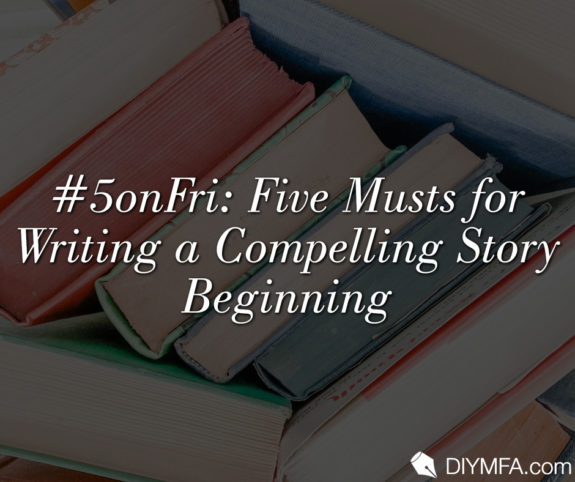The beginning of your book, as much as the back cover or inside flap, is marketing copy. Your reader will give you wide latitude when it comes to your opening content, but if they’re going to stick around, they expect something enticing on the first page—a promise of things to come. Whether your first paragraphs strap your reader to a catapult or simply extend a hand in invitation, there are some considerations you must keep in mind when it comes to writing a compelling story beginning.
Clarity of Voice
The issue of voice is the issue on which all other beginning-issues hang. Let me simplify what I’m talking about when I say “voice”. Here’s a question for you: Who is telling this story and why? The who AND the why are going to provide the necessary filter you need to properly narrate your book. That narrative filter is going to guide your point-of-view, your language and diction choices, where the story begins, and the entire experience you give your reader.
We’ve all read work in which the narrator sounds vaguely like the author, and in fiction, the narrator should never be the author. Story beginnings in which the writer hasn’t nailed down the voice will suffer from a lack of clarity and purpose.
If you’re writing creative nonfiction, you’re not off the hook. Even in memoir you still put on a mediating persona, a voice that might be jaunty, reserved, self-assured, indignant, etc. Voice is the necessary filter through which you will establish a connection with your reader.
Right Starting Point
Besides figuring out the events of your story, you have to make decisions about the order in which those events will be revealed. There is no one perfect starting place, but your reader is going to need characterization, setting, and a potential problem asap. Of those three, invoking character reigns supreme. In fact, the way your narrator conveys the setting and potential conflict should be infused with some aspect of character.
Oftentimes writers fall back on sort of lax and default beginnings—they struggle to get past the throat-clearing stage because they have not made a clear decision about where to begin. Wherever you decide to start, your beginning must be setting up your inciting incident, the event that will set your main character on a path from which they cannot turn back.
You might want to start in media res, in the middle of things. Jumping right into scene can work great, as long as your reader isn’t missing important context which will cause them to be lost by the second page. And one of the traps we can fall into when we are focused on providing context is relying on flashback.
Flashback beginnings are often a recap of facts that, frankly, are dead on the page. If your flashback beginning is informational rather than something that the reader can experience, it risks being dull. And if your flashback is as compelling as what’s happening in the present, you might consider making it part of the current action. Yes, stuff has happened before the story starts. Let that be the wind at your characters’ backs, the force that propels the story forward. You can weave in the backstory later.
Grounding and Grab
I know a writing professor who bans his students from beginning a piece of writing with the weather. Also, one of my favorite novels begins with the weather. Why would someone ban it?
Because sometimes writers fall back on what is safe—not unlike the way we resort to the weather in small talk. We haven’t yet decided how to create an adventure for our reader so we stick to what we know: character ages, dates, cities, the color of the sky (oops, I’m back to weather).
Any of those things can work in the beginning, but they often don’t work because a writer doesn’t have a strong purpose in mind. The beginning of your story conveys to the reader the nature of the story they are about to experience. The last thing you want to convey is that this story is going to be data-filled, aka boring.
No matter what content you choose to convey first, make it atmospheric, immersive, surprising. Think about giving your reader a sharp sensory moment like William Faulkner does in “Barn Burning”:
“The store in which the Justice of the Peace’s court was sitting smelled of cheese.”
Think about how you might set the stage and raise expectations. Your beginning establishes the emotional grounding for your story, so think about how you want your reader to feel when they read it.
Trustworthy Prose
The beginning must not only be as polished as the rest of the work, it must be near perfect (no pressure). The style can be simple or more ornate, but your beginning is going to be the least forgiving place for slack writing. You might be able to bury a flabby sentence on page 57, but it will stand out on page one.
Your beginning breaks the silence. It offers you an immediate opportunity to garner the attention of your reader and lets them know they are in good hands. One of the best ways you can pique a reader’s interest is through the use of unusual or interesting language. In Stein on Writing, Sol Stein uses the opening from Budd Schulberg’s What Makes Sammy Run to teach about beginnings:
“The first time I saw him he couldn’t have been more than sixteen years old, a ferret of a kid, sharp and quick. Sammy Glick. Used to run copy for me. Always ran. Always looked thirsty.”
Not only do we have characterization and tone-setting here, but look at the way the words “ferret” and “thirsty” stand out. Ask yourself what possibilities an unexpected word-choice might offer.
Fancy prose isn’t the goal. You’re not trying to impress, you’re trying to entice. The goal of page one is to get your reader to continue to page two.
Study What Others Have Done
Maybe this isn’t a must, but you should do it. Your bookshelf is full of story openings for you to learn from. Pull ten books off your shelf and read the first pages. Note what the author is doing. If they start with setting (or weather) how do they do it to good effect? Who or what gets introduced right away? How are they establishing voice? How do they use language to set a tone of apprehension, mystery, or playfulness? What groundwork is being laid for the inciting incident?
Ask yourself if any of those techniques could work for your piece. It’s important for you to know what, specifically, you want to achieve in your story beginning, but let me help take the pressure off a bit. Getting your opening right is hard, and you can labor over it until you start losing enthusiasm for the work. If you get to this point, put it aside and move on with your story. You can come back to the beginning later. It’s possible that a scene you write for the middle of your book ends up being the one you want to start with. Sometimes the beginning is the part that gets finished at the end.

KIM LOZANO is an editor and creative writing coach from St. Louis. Although she loves to travel, her heart and writing are always calling her home to the Great Plains. Her own work has been published in Alaska Quarterly Review, Third Coast, The Iowa Review, North American Review, and many other publications. You can find out more about her coaching at kimlozano.com.







